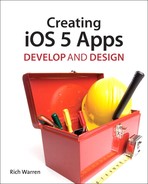i. Introduction
Welcome to Creating iOS 5 Apps
This book serves two goals: introducing new developers to iOS development, and educating experienced developers about the tools and technologies available in iOS 5. We will examine a wide range of subjects—some new and some old—covering everything from building an initial iOS project to submitting your app to the iTunes App Store. Throughout this book, we focus on a few key points, providing a firm beachhead for launching your own explorations. For more information on this book, including bonus chapters, sample code, and FAQs, check out www.freelancemadscience.com/book.
iOS 5 Technologies and Tools
Over the course of this book, we will discuss the key technologies and development tools you will need to create high-quality iOS applications. Let’s take a look at the most important of these.
![]()
Automatic Reference Counting
Automatic Reference Counting (ARC) simplifies memory management for Objective-C objects. ARC automatically tracks the object’s lifetime, automatically retaining and releasing our objects as needed. This both streamlines our code and reduces the chances of memory-related bugs. And ARC, unlike garbage collection, manages our object’s memory at compile time. This means that ARC-based code runs as fast as, if not faster than, manually managed memory.
![]()
Storyboards
For years, Interface Builder allowed us to graphically design our user interfaces, drawing connections between our controls and our actions. With storyboards, we can extend this even further, drawing the relationships and segues between the different scenes in our application. This lets us sketch out and edit our entire application’s workflow, greatly simplifying the creation of new applications.

iCloud Storage
Without a doubt, iCloud is the most important new feature in iOS 5. The iCloud storage API allows us to sync our application’s data across all of the user’s devices. From their iPhones and iPads to their Macs or PCs, our users can now have ubiquitous, always-up-to-date access to all their information. iCloud storage is rapidly becoming a must-have feature for all serious applications.

Xcode
Xcode provides an integrated development environment, giving us a wide range of tools to both create and manage our projects. It handles everything from running and debugging our code to designing our UI and data models. As iOS developers, we will spend most of our time in Xcode. Having a well-grounded understanding of its features is essential to our success.

iOS Simulator
The iOS Simulator application lets us run, debug, test, and profile our code directly on a Mac. While the simulator will never replace testing on an actual device, it has a number of advantages. For example, developers can begin using the simulator before they join the iOS Developer Program. It’s also easier and faster to run quick tests in the simulator, letting us perform rapid develop/test/iterate cycles as we add new features to our applications.

Instruments
Apple’s premier profiling tool, Instruments lets us dynamically trace and analyze code running either in the simulator or directly on an iOS device. It lets us track and record everything from object allocations and timer-based samples to file access and energy use. It also provides the tools necessary for sifting through and analyzing the data that it generates. In experienced hands, Instruments can help us to fix bugs and polish our code.
